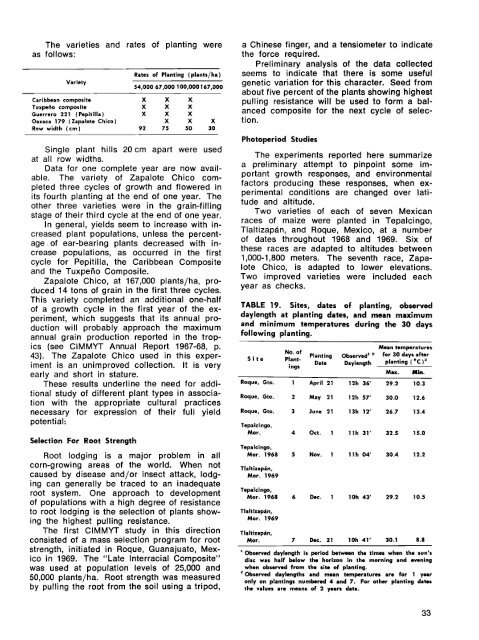REPORT - Search CIMMYT repository
REPORT - Search CIMMYT repository
REPORT - Search CIMMYT repository
Create successful ePaper yourself
Turn your PDF publications into a flip-book with our unique Google optimized e-Paper software.
The varieties and rates of planting were<br />
as follows:<br />
Variety<br />
Caribbean composite<br />
Tuxpeiio composite<br />
Guerrero 221 (Pepitilla)<br />
Oaxaca 179 (Zapalote Chico)<br />
Row width (em)<br />
Rates of Planting (plants/ha)<br />
54,00067,000100,000167,000<br />
Single plant hills 20 cm apart were used<br />
at all row widths.<br />
Data for one complete year are now available.<br />
The variety of Zapalote Chico completed<br />
three cycles of growth and flowered in<br />
its fourth planting at the end of one year. The<br />
other three varieties were in the grain-filling<br />
stage of their third cycle at the end of one year.<br />
In general, yields seem to increase with increased<br />
plant populations, unless the percentage,of<br />
ear-bearing plants decreased with increase<br />
populations, as occurred in the first<br />
cycle for Pepitilla, the Caribbean Composite<br />
and the Tuxpeno Composite.<br />
Zapalote Chico, at 167,000 plants/ha, produced<br />
14 tons of grain in the first three cycles.<br />
This variety completed an additional one-half<br />
of a growth cycle in the first year of the experiment,<br />
which suggests that its annual production<br />
will probably approach the maximum<br />
annual grain production reported in the tropics<br />
(see <strong>CIMMYT</strong> Annual Report 1967-68, p.<br />
43). The Zapalote Chico used in this experiment<br />
is an unimproved collection. It is very<br />
early and short in stature.<br />
These results underline the need for additional<br />
study of different plant types in association<br />
with the appropriate cultural practices<br />
necessary for expression of their full yield<br />
potential:<br />
Selection For Root Strength<br />
x<br />
X<br />
X<br />
92<br />
x<br />
X<br />
X<br />
X<br />
75<br />
X<br />
X<br />
X<br />
X<br />
50<br />
X<br />
30<br />
Root lodging is a major problem in all<br />
corn-growing areas of the world. When not<br />
~aused by disease and/or insect attack, lodg<br />
Ing can generally be traced to an inadequate<br />
root system. One approach to development<br />
of populations with a high degree of resistance<br />
to root lodging is the selection of plants showing<br />
the highest pulling resistance.<br />
The first <strong>CIMMYT</strong> study in this direction<br />
consisted of a mass selection program for root<br />
strength, initiated in Roque, Guanajuato, Mexico<br />
in 1969. The "Late Interracial Composite"<br />
was used at population levels of 25,000 and<br />
50,000 plants/ha. Root strength was measured<br />
by pulling the root from the soil using a tripod,<br />
a Chinese finger, and a tensiometer to indicate<br />
the force required.<br />
Preliminary analysis of the data collected<br />
seems to indicate that there is some useful<br />
genetic variation for this character. Seed from<br />
about five percent of the plants showing highest<br />
pulling resistance will be used to form a balanced<br />
composite for the next cycle of selection.<br />
Photoperiod Studies<br />
The experiments reported here summarize<br />
a preliminary attempt to pinpoint some important<br />
growth responses, and environmental<br />
factors producing these responses, when experimental<br />
conditions are changed over latitude<br />
and altitude.<br />
Two varieties of each of seven Mexican<br />
race~ of maize were planted in Tepalcingo,<br />
Tlaltlzapan, and Roque, Mexico, at a number<br />
of dates throughout 1968 and 1969. Six of<br />
these races are adapted to altitudes between<br />
1,000-1,800 meters. The seventh race, Zapalote<br />
Chico, is adapted to lower elevations.<br />
Two improved varieties were included each<br />
year as checks.<br />
TABLE 19. Sites, dates of planting, observed<br />
daylength at planting dates, and mean maximum<br />
and minimum temperatures during the 30 days<br />
following planting.<br />
No. of<br />
5 i t e Plantings<br />
Mean temperatures<br />
Planting Observed ' • for 30 days after<br />
Date Daylength planting ( °C)'<br />
Max.<br />
Min.<br />
Roque, Gto. April 21 12h 36' 29.2 10.3<br />
Roque, Gto. 2 May 21 12h 57' 30.0 12.6<br />
Roque, Gto. 3 June 21 13h 12' 26.7 13.4<br />
Tepalcingo,<br />
Mor. 4 Oct. llh 31' 32.5 15.0<br />
Tepalcingo,<br />
Mor. 1968 5 Nov. 1 11 h 04' 30.4 12.2<br />
Tlaltizapan,<br />
Mor. 1969<br />
Tepalcingo,<br />
Mor. 1968 6 Dec. 10h 43' 29.2 10.5<br />
Tlaltizapan,<br />
Mor. 1969<br />
Tlaltizapan,<br />
Mor. 7 Dec. 21 10h 41' 30.1 8.8<br />
1 Observed daylength is period between the times when the sun's<br />
disc was half below the horizon in the morning and evening<br />
when observed from the site of planting.<br />
• Observed daylengths and mean temperatures are for 1 year<br />
only on plantings numbered 4 and 7. For other planting dates<br />
the values are means of 2 years data.<br />
33

















